Travertine floors infuse a space with timeless charm and sophistication, making them a popular choice for homeowners. However, improper cleaning methods can irreparably damage them. If you reside in Kingston-upon-Thames and are considering using a steam cleaner on your stone floors, halt immediately. What may appear to be a benign cleaning solution could lead to hidden damages that might prove costly to rectify. In this comprehensive guide, we explore the tangible effects of steam cleaning travertine, share local insights for proper care, and suggest intelligent, safe alternatives to maintain your floors in pristine condition.
Discover the Unique Characteristics of Travertine and Its Benefits
Travertine is a distinctive type of limestone formed through mineral deposits found in hot springs. Its porous nature and softer texture compared to granite contribute to its natural, earthy aesthetic, enhancing the elegance of any home. However, this porosity also makes it susceptible to absorbing water, cleaning agents, and dirt, necessitating careful maintenance.
Travertine is available in various finishes that affect its appearance and maintenance:
- Honed: Features a smooth, matte finish, making it a popular choice for floors.
- Polished: Shiny and reflective, ideal for adding a touch of glamour.
- Tumbled or Brushed: Offers a rustic look with textured surfaces for a more natural feel.
Understanding the specific type of travertine you have is crucial before embarking on any cleaning regimen, as different finishes respond uniquely to moisture, heat, and physical pressure.
Why You Should Avoid Steam Cleaning Your Travertine Floors
In summary: Using a steam cleaner on travertine floors is discouraged.
How Heat and Moisture Can Compromise Travertine’s Integrity
Steam cleaners deliver high-temperature vapour onto surfaces. Given travertine's porous structure, this can lead to:
- Absorption of steam into the stone
- Long-term weakening or loosening of the stone’s structural integrity
- Surface etching or a dull appearance
Understanding the Impact of Steam on Sealants
Travertine flooring should always be protected with a sealant. Nevertheless, steam can:
- Penetrate and degrade the sealant prematurely
- Induce microfractures within the stone
- Result in unsightly water marks and hazing on the surface finish
❌ How Steam Traps Dirt in Travertine’s Pores
While steam may loosen dirt, without proper extraction, it can inadvertently push grime deeper into the stone, leading to:
- Gradual discolouration
- The formation of soils within the stone
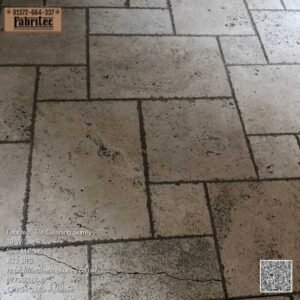
Effective Cleaning Techniques for Travertine Floors in Kingston-upon-Thames
✅ Opt for pH-Neutral Cleaners for Safe Maintenance
Harsh alkaline or acidic cleaners, such as vinegar or bleach, can degrade the stone's quality. Instead, consider:
- Utilising pH-neutral cleaners specifically formulated for natural stone
- Searching for local brands or UK-imported solutions that ensure safety for your stone surfaces
✅ Use a Damp Microfibre Mop for Gentle Cleaning
Steer clear of overly saturated mops that can harm your travertine. A damp (not wet) microfibre mop effectively cleans without overwhelming the surface with moisture.
✅ Ensure Immediate Drying After Mopping
It is vital to dry travertine floors promptly after mopping to avert moisture seepage. You can achieve this by using:
- Clean, dry cloths
- Floor fans, especially in areas with poor ventilation
✅ Re-Seal Your Floors Every 1–2 Years for Optimal Protection
Given the humid climate in the UK, particularly in older homes in Kingston with limited airflow, the frequency of sealing is essential for maintaining the integrity and appearance of your travertine.
Smart Alternatives to Steam Cleaning for Travertine Floors
| Cleaning Method | Is it Safe for Travertine? | Additional Notes |
|---|---|---|
| Dry Dust Mopping | ✅ | Perfect for daily upkeep |
| Damp Mop with pH-Neutral Cleaner | ✅ | Recommended for weekly cleaning |
| Steam Mop | ❌ | Risks damaging the stone’s pores and sealant |
| Acidic Solutions (such as Vinegar) | ❌ | Can corrode the stone's surface |
| Stone-Specific Cleaners | ✅ | Options include LTP Floorshine, LTP Waxwash, Fila Multi Surface Cleaner, and HG natural stone cleaner for a streak-free finish.
Always perform a spot test first. |
| Professional Stone Cleaning Services | ✅ | Ideal for deep cleaning and restoration |
Identifying Signs of Steam Damage on Your Travertine Floor
- Dull patches or etched areas that detract from its beauty
- White haze or chalky residue indicating moisture issues
- Cracking or flaking that compromises structural integrity
- Efflorescence, which appears as a white powder due to moisture migration
Explore Local Travertine Care Services in Kingston-upon-Thames
Travertine Care in Kingston-upon-Thames is a service that combines modern solutions with the charm of historical architecture. Many homes in this area feature traditional stone floors, and local homeowners and property managers can rely on professional travertine cleaning services provided by Fabritec Tile Cleaning located in New Malden.
Is Your Travertine Floor Looking Grubby?

This customer in Kingston-upon-Thames possessed a stunning travertine floor, yet the tiles had lost their original elegance after frequent cleaning with a domestic steam cleaner. The tiles became dull, soiled quickly post-cleaning, and absorbed stains like a sponge.
Initially, the owner contemplated replacing the entire floor. Thankfully, they reached out to their local professionals, Fabritec, and that’s where the restoration process began.
Revitalising a Travertine Tiled Floor Through Deep Cleaning
The first step was to restore the stone's appearance and structural integrity through an extensive deep cleaning process. Travertine requires more than a basic wipe-down; effective cleaning necessitates mechanical abrasion and precision.
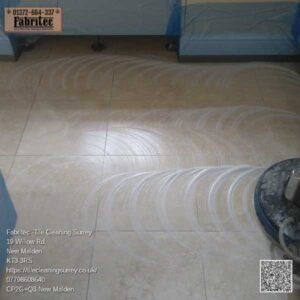
- I commenced with a 200-grit pad mounted on a rotary floor machine. By employing slow, circular motions, the pad effectively opened the stone's surface, enabling the removal of embedded dirt and worn finishes. This process generated a substantial amount of slurry—a mixture of water and loosened stone particles—that needed to be thoroughly rinsed and vacuumed.
- After the initial pass, I progressed through a series of finer grits: 400-grit, 800-grit, and ultimately, 1500-grit. Each stage involved multiple passes to gradually refine the stone’s finish and enhance its natural lustre. With each grit level, more slurry was produced and meticulously extracted to ensure a clean, residue-free surface.
- Significantly, this restoration process is entirely mechanical—no chemical strippers were used, only water. The combination of the abrasive pads and manual effort alone revealed the stone’s inherent beauty.
Once the surface was restored, focus shifted to the grout lines, which were heavily soiled and had not responded well to pad cleaning. As rotary pads cannot effectively reach into recessed grout lines, I employed specialised equipment for thorough cleaning.
Effective Grout Cleaning: A Crucial Step in Restoration
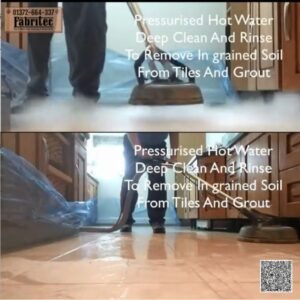
I applied a robust stone-safe cleaner and degreaser, meticulously working it into the surface using a scrubbing machine. This technique helps to break down accumulated grime and emulsify greasy residues lodged in the pores and grout lines. I allowed it to sit for approximately 10 minutes to penetrate and loosen the embedded soil.
Next, I utilised our high-pressure hot water rinse and capture system, which blasts hot water deep into the tiles. This process flushes out grime from both the grout lines and the natural pits in the travertine that scrubbing alone cannot reach.
Thanks to the heat and efficient vacuum extraction, the floor dries remarkably quickly. This not only prevents moisture from reabsorbing into the stone but also prepares the surface for sealing sooner—often within an hour.
Sealing Your Travertine Tiled Kitchen Floor for Longevity
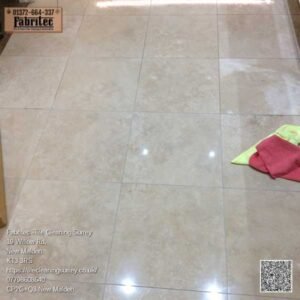
The homeowner desired to maintain a natural aesthetic, so I applied a high-quality impregnating sealer that is ideal for polished stone surfaces, ensuring long-lasting protection and beauty.
Frequently Asked Questions About Steam Cleaning Travertine in Kingston-upon-Thames
What is the Best Method to Sanitize Travertine Without Using Steam?
Utilise a diluted pH-neutral cleaner paired with a microfibre cloth. For a more thorough sanitation, consider hiring a professional service.
Is Professional Help Necessary for Re-Sealing My Travertine?
Not necessarily. While DIY kits are available, a professional ensures comprehensive coverage and selects the most suitable product for your specific floor type.
What Effects Occur If Water Stands on Travertine?
Standing water can penetrate the stone, leading to dark patches, weakening the structure, and potentially resulting in mould growth.
Can Travertine Floors Be Buffed After Experiencing Steam Damage?
Yes, minor etching or haziness may be rectified through honing and polishing. It is advisable to consult a stone care expert for best results.
Valuable Resources for Travertine Care
The article Should You Steam Clean Travertine Floors? A Comprehensive Guide for Homeowners in Kingston-upon-Thames originally appeared on Tile Cleaning Surrey.
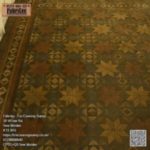

I found your insights on travertine flooring truly engaging! It’s fascinating how such a beautiful material can be both a design statement and a challenging element when it comes to maintenance. I completely share your concern regarding steam cleaning—it’s so easy to overlook the unique characteristics of natural stone in favor of what feels like a quick fix.
I’m glad you found the insights on travertine flooring engaging! It really is a conundrum, isn’t it? You’ve got this stunning natural stone that practically begs to be admired, yet requires a bit of TLC to keep looking its best. It’s like having a pet peacock—gorgeous to behold but somewhat high maintenance when it comes to grooming.
I really appreciate how you’ve highlighted both the beauty and the fragility of travertine floors. When I first moved into my house, I was immediately drawn to the rich textures and earthy tones of travertine. It felt like a sophisticated choice that paired well with my vision for a cozy yet elegant space. However, like many homeowners, I quickly learned that what looks beautiful often comes with its own set of challenges, especially when it comes to maintenance.
You’ve hit the nail on the head with the charm and challenges of travertine. It’s that unassuming beauty that lures us in, right? It almost feels like the stone is whispering, “Pick me, I’m sophisticated and elegant,” while simultaneously hiding a cheeky grin, knowing the maintenance hurdles it comes with.
“I’m so glad to hear you resonate with the charm of travertine! If you’re looking for tips to maintain its beauty while keeping your space cozy and elegant, check out these expert maintenance guides that can help you preserve that stunning appeal.”
https://fabritec.org/fb
It’s fascinating how travertine manages to blend natural beauty with a sense of sophistication in our homes. Just the thought of its earthy tones and unique textures adds so much warmth to a space! However, your caution about steam cleaning really struck a chord with me. I remember when I first installed travertine in my own home; I was so eager to keep it looking pristine that I instinctively reached for a steam cleaner, thinking it would give a deep clean. Luckily, I stumbled upon information like yours beforehand, which saved me from making a costly mistake.
You’ve touched on a crucial aspect of caring for travertine that many homeowners overlook. The allure of its earthy tones and unique textures can indeed tempt anyone to go to extremes in keeping it looking new. Your experience with steam cleaning highlights a common pitfall; it’s easy to assume that more aggressive cleaning methods equate to better results.
“I’m glad to hear you found the information helpful! If you’re looking for more tips on maintaining your travertine’s beauty, check out this resource that dives deeper into care techniques.”
https://fabritec.org/lp
Your discussion about the risks of using steam cleaners on travertine floors raises an essential point about how often we overlook the unique needs of different flooring materials. I’ve seen firsthand how homeowners, dazzled by the idea of quick cleaning solutions, can unwittingly cause more harm than good. The porous quality of travertine, while giving it character, also necessitates a more refined cleaning approach.
Your insights on the importance of properly maintaining travertine floors really resonate with me. I’ve always been drawn to the natural elegance that travertine brings to a space, but I had no idea that steam cleaning could pose such risks. It’s interesting how what seems like a modern solution can sometimes lead to more harm than good.
I appreciate your thoughts on travertine floors. They truly do bring a unique warmth and character to any space. It’s interesting to note that even well-meaning cleaning methods can backfire. Steam cleaning might seem like a simple, effective way to keep surfaces pristine, but the heat and moisture can easily damage the stone’s porous structure over time.
It’s interesting how we can be lured in by the allure of shiny gadgets, only to find out they might not be the right fit for our delicate travertine buddies. The elegance of travertine is hard to resist—it’s like the James Bond of flooring, sophisticated and timeless. But finding out that steam cleaning can be an enemy in disguise is a real plot twist.
I’m glad you found the insights helpful! If you’re looking for tips on how to care for your travertine floors without the risks of steam cleaning, check out this guide for expert advice.
https://fabritec.org/ig
I can really relate to the concerns you’ve raised about travertine floors. They do have that beautiful aesthetic that can truly elevate a space, but I never realized how delicate they can be when it comes to cleaning. It’s interesting how something that seems so innocuous, like steam cleaning, could potentially ruin such a prized feature in our homes.
I hear you on the beauty of travertine; it really does add a unique charm to a space. It’s crazy how something that looks so sturdy can be so sensitive. With steam cleaning, it’s like trying to solve a problem with a new gadget, but sometimes those gadgets can make things worse.
I’m glad you can relate! If you’re looking to maintain the beauty of your travertine floors while avoiding common pitfalls, check out this helpful resource that provides tips on proper care and cleaning.
https://fabritec.org/lp
This guide on travertine floors couldn’t have come at a better time for me! With their natural beauty and charm, I’ve often been tempted to steam clean my floors in hopes of keeping them as pristine as possible. But learning about the potential hidden damages really makes you reconsider, doesn’t it?
It’s fascinating how the beauty of travertine can both elevate a space and pose challenges for homeowners at the same time. I appreciate your warning about steam cleaning, as I’ve seen firsthand the kind of damage that can occur from well-meaning but misguided cleaning methods.
The intricate nature of travertine truly does present both a stunning aesthetic and a unique set of challenges for home maintenance. As someone who has incorporated natural stone into my own home design, I can certainly appreciate the allure of this material. The earthy tones and textures it brings can transform a space into something genuinely special. However, I also resonate deeply with your cautionary advice regarding steam cleaning. Many homeowners might not realize that steam, with its ability to penetrate and sanitize, can actually do more harm than good when it comes to porous stones like travertine.
Your insights on travertine floors resonate deeply, especially considering how often homeowners overlook the fragility of natural stone. I’ve experienced firsthand how beautiful travertine can be, but I learned the hard way about the potential risks associated with improper maintenance. When I moved into a home with travertine tiles, I initially used a steam cleaner out of convenience, not realizing that the heat and moisture could seep into the porous stone, leading to unsightly stains and deterioration.